When The Gods Rest…Pattachitra
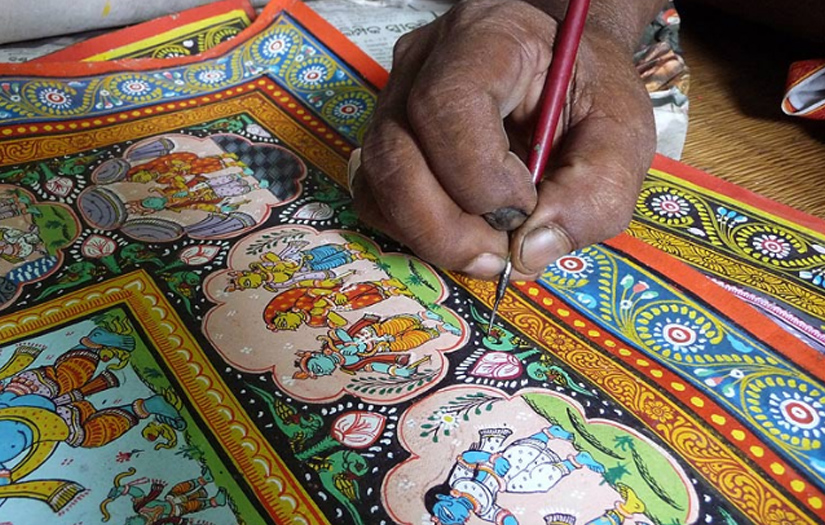
Misty daybreak and the first calls of the rooster in a scenic village have the men going to the river for ablutions, preparing themselves for a day filled with enchanting images of colourful deities, materialising from fine brushes and bright stone paints.
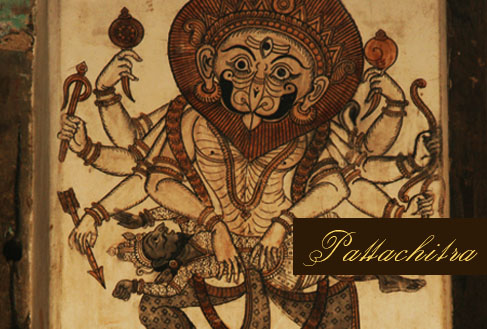
Pattachitra on Wall
Raghurajpur, a small village on the banks of the river Bhargabi near Puri, is a haven of Pattachitra, the cloth paintings of Orissa, and has attracted the attention of the world as a Heritage village. The economic, social and cultural life of this village revolves around arts and crafts with atleast one member from almost every family involved in the arts. There is an informal division of work in the family and every member is engaged in doing something or the other related to paintings. While the men folk and the boys work on the paintings, the women are busy preparing the canvas, boiling the gum or powdering the pigments in a mortar.
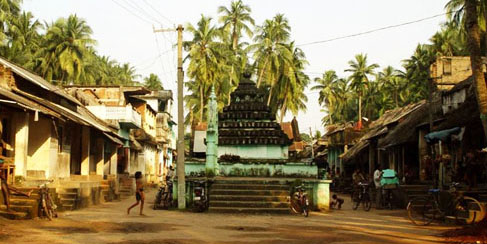
Pattachitra paintings find expression in many ways commonly seen; in story paintings, on walls, in Ganjifa (locally known as Ganjapa) cards, and in many other forms, but they are also the only paintings that replace the idols of Gods and are regarded with the same reverence.
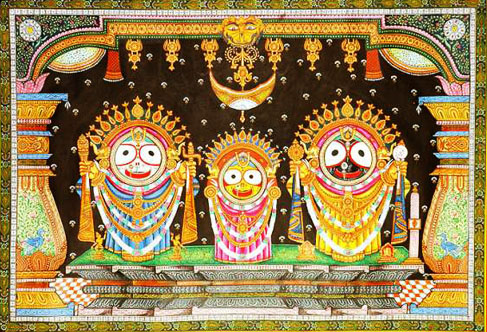
On the Debasnana Purnima day (Full moon day of Jyestha month), the Gods of Jagannath, Puri, have a ritualistic bath to fight the heat of summer. As a result the deities become sick for fifteen days, i.e., the first fortnight of Asadha. During this period, known as Anasar, the devotees don’t have Darshan of their beloved Lord at the Ratnavedi. Instead, three paintings, of Lord Jagannath (a form of Krishna), Lord Balabhadra and Maa Subhadra, in the colours black, white and yellow respectively, are worshipped.
Such paintings, known as “Anasar Patti”, are made by traditional Chitrakaras of Orissa, who are experts in the art of Pattachitra. Patta paintings of Orissa have evolved and flourished under the cult of Lord Jagannath and therefore, considered to be as old as the temple of Lord Jagannath at Puri, i.e. 12th Century A.D.
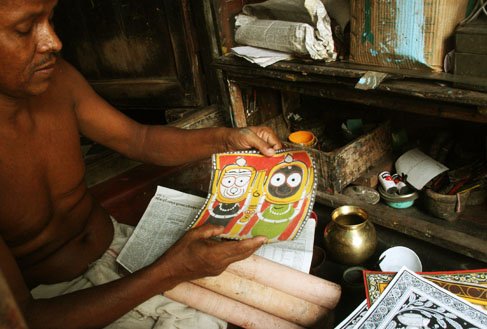
As an elaboration of this painting tradition, paintings on the triad, known as “Yatri Patti” (traveler – painting), are sold in large numbers to the pilgrims coming to Puri, as a souvenir for their visit to Puri Dham. Since the pattachitra has its origin in the Jagannath temple, the triad has always been the main theme of the pattas. Most of the themes of traditional Pattachitra are mystical stories from Ramayan and Mahabharat including that of Lord Jagannath, their perennial source of inspiration.
Pattachitra has a distinctive style of painting the Gods and Goddesses not in naturalistic colours, but according to certain conventions wherein the‘sattvika’, ‘rajasika’ and the ’tamsika‘ aspects of the Gods are expressed in white, red and black colors respectively. The characters have their own colours according to the “Rasa” they portray, for example, “Hasya” or laughter inducing in white, “Raudra” or furious in red, “Abdhuta” or strange in yellow, and so on.
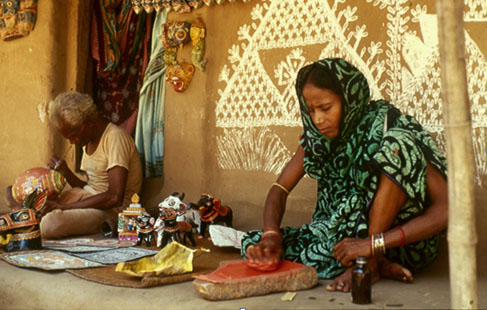
The colors used are bright white, red, yellow, blue, green and black and are prepared from natural ingredients. White is prepared from powder of conch-shell, yellow from Haritala, a kind of stone, red from geru (red oxide stone) and Hingula or black from burning lamp and coconut shell, blue from indigo and green from leaves. Natural gum of a fruit called ‘kaitha’ is mixed with the colors along with water in coconut shells while painting to ensure their fastness.
The preparation of ‘pattis’ or the canvas for painting involves binding two layers of cotton fabric with a gum made from tamarind seeds and then coating it with a white paste made of a powdered limestone and tamarind seeds. Once this is dry, the cloth is polished to make it smooth and suitable for painting.
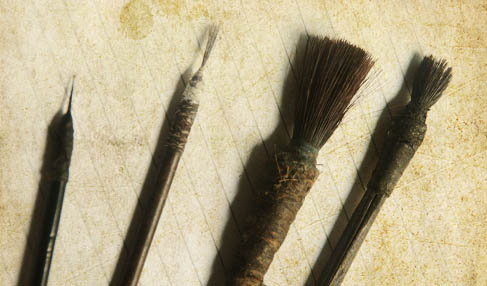
The chitrakara of Orissa uses buffalo hair to make brushes for the thick lines while rat or squirrel hair is used for making brushes meant for finer line work. According to the text, ‘Manasaullasa’, the crayon for initial sketches or ‘vartika’ is to be made by mixing lamp black with boiled rice paste and rolled into sticks. According to yet another text,‘Shilparatna’ ‘kitta lekhani’ or the writing/drawing instrument was a wick made out of the dust of bricks and dried cowdung made into a paste.
In the typical style of Pattachitra, the faces of characters have long beak like noses, prominent chins and elongated eyes. They are distinguished from each other by facial features, hairstyles, clothing etc. Central focus of the painting is the expression of the figures and the emotion they portray, the strong colors only reinforce them.
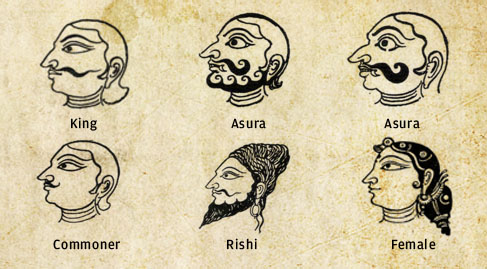
One of the most distinct features of patta is the variety of ornate borders that are used to give a frame like appearance. The traditional borders are derived from the temple sculpture motifs of Orissa. One of the most popular border designs is that of two entwined snakes which can also be seen on the doorway of the Konark temple.
Pattachitra has largely remained uninfluenced by the other schools of Indian paintings namely the Mughal and Pahadi, due to the fact that Orissa had remained uninvaded by the Muslim rulers for a fairly long time giving the art form enough time to evolve its own unique styles and convention and establish the same. This has allowed the art to form its own category – the Puri school of painting.
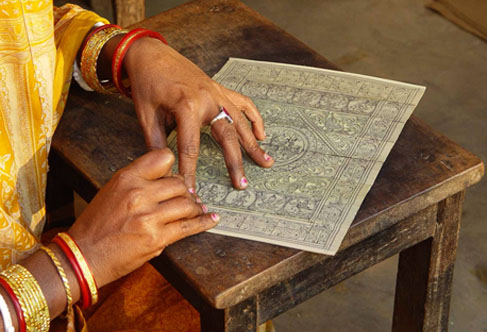
Chitrakaras today send their children out for exposure and education apart from training them in their family art tradition to ensure that they can run their own business rather than depending on middlemen. Women have also taken up full time painting. Many young girls and women are now under training with a considerable number coming from outside the village as well.
The Pattachitra paintings that originate in such small idyllic villages reach across the world. Soaked in Puranic culture and classical romances, with vibrant colours and superb craftsmanship, the Pattachitra has become a distinct art form and has captured the imagination of artists and art lovers alike both in India and abroad.
Read in detail here ~ Gaatha.org
Buy Pattachitra online ~ Shop.gaatha.com

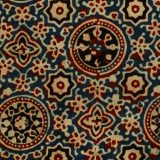
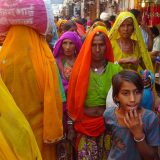








arjun
hi i would like to buy pattachitra painting to gift to my corporate client….im based in bby…kindly advise
regards
gaatha_home
Hi… Please select a painting of your choice at shop.gaatha.com/buy-pattachitra
To connect for any further assistance please mail us on [email protected]
RAHUL RAHUL
babail